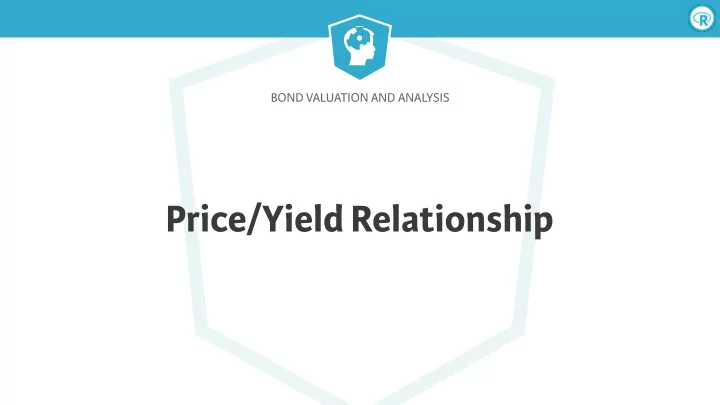

BOND VALUATION AND ANALYSIS Price/Yield Relationship
Bond Valuation & Analysis Inverse Relationship
Bond Valuation & Analysis Credit Ratings S&P Fitch Moody's Investment AAA AAA Aaa Grade AA AA Aa A A A BBB BBB Baa High Yield BB BB Ba B B B CCC - Lower CCC - Lower Caa - Lower
Bond Valuation & Analysis Determining a Bond’s Yield ● Use yields of bonds with same credit rating ● If we want to value a Baa-rated bond, we can get the data from Quandl package > library(Quandl) > baa <- Quandl("MOODY/DBAAYLD") > head(baa) DATE VALUE 1 2016-10-07 4.36 2 2016-10-06 4.36 3 2016-10-05 4.36 4 2016-10-04 4.35 5 2016-10-03 4.29 6 2016-09-30 4.29
BOND VALUATION AND ANALYSIS Let’s practice!
BOND VALUATION AND ANALYSIS Components of Yield
Bond Valuation & Analysis Baseline Component of Yield ● Risk-free yield (baseline rate) ● Yield on recently issued US Treasury with similar maturity ● Risk-free yield is not constant ● A ff ected by economy, market interest rates, and inflation
Bond Valuation & Analysis Obtaining Treasury Data ● Use quantmod package ● Obtain 10-Year Treasuries (“DGS10”) Identifies from FRED source of data > library(quantmod) > t10yr <- getSymbols("DGS10", src = "FRED", auto.assign = FALSE) > head(t10yr) DGS10 1962-01-02 4.06 1962-01-03 4.03 1962-01-04 3.99 1962-01-05 4.02 1962-01-08 4.03 1962-01-09 4.05
Bond Valuation & Analysis Spread Component of Yield ● Spread ● Primarily the credit spread = risk that issuer will default ● May contain premiums for other risks
Bond Valuation & Analysis Risks of Investing in Bonds ● Credit Risk: Risk of default by issuer ● Inflation Risk: Risk that inflation eats up value of cash flows received from bond ● Call Risk: Risk that issuer will buyback the bond at a time that is disadvantageous to the investor ● Liquidity Risk: Risk that you cannot sell the bond for a price that is at or near its value
Bond Valuation & Analysis Time-Varying Risk Premiums ● Depends on market’s current appetite for risk ● Nervous markets larger risk premium ● One measure is Investment Grade spread (i.e., di ff erence in Baa and Aaa yields) ● We can obtain Moody’s Aaa and Baa Index yields from the Quandl package
BOND VALUATION AND ANALYSIS Let’s practice!
BOND VALUATION AND ANALYSIS Estimating the Yield of a Bond
Bond Valuation & Analysis Finding the Yield By Trial-and-Error ● For traded bonds, we can imply the yield ● If you know the price and the bond’s cash flows, you can make “guesses” as to what the yield is ● The “correct” yield equates the price of the bond with the PV of the bond’s cash flows
Bond Valuation & Analysis Iterating Through Di ff erent Guesses ● Consider bond with $100 par value, 5% coupon rate, 10 years to maturity, and a price of $92.64 ● 1st Guess: 5% Price is $100 (too high) ● 2nd Guess: 7% Price is $85.95 (too low) ● 3rd Guess: 6% Price is $92.64 (correct)
Bond Valuation & Analysis Automating the Process ● Trial-and-error is ine ffi cient ● Fortunately, we can use the uniroot() function in R to help us automate the process
Bond Valuation & Analysis Create Function Using uniroot() > ytm <- function(cf) { uniroot(bval, c(0, 1), cf = cf)$root } ● Create the ytm() function using uniroot() ● Function takes a modified cash flow vector ( cf ) and uses a modified bond valuation function ( bval ) c(0,1) limits the interval for the search to a yield ● between 0% and 100%
Bond Valuation & Analysis Modified Cash Flow Vector > cf <- c(-92.64, 5, 5, 5, 5, 5, 5, 5, 5, 5, 105) ● First element is bond’s price entered as a negative number ● Second element onwards are the bond’s cash flows - coupons plus par value ● Same bond: Price is -$92.64, par value is $100, 5% coupon rate, and 10 years to maturity
Bond Valuation & Analysis Modified Bond Valuation Function > bval <- function(i, cf, t = seq(along = cf)) sum(cf / (1 + i)^t) ● Need to create bond valuation function bval() that uses the modified cash flow vector ( cf ) ● Same logic as our bondprc() function ● Create time indicator ( t ) ● Discount cash flow using interest rate ( i )
BOND VALUATION AND ANALYSIS Let’s practice!
Recommend
More recommend